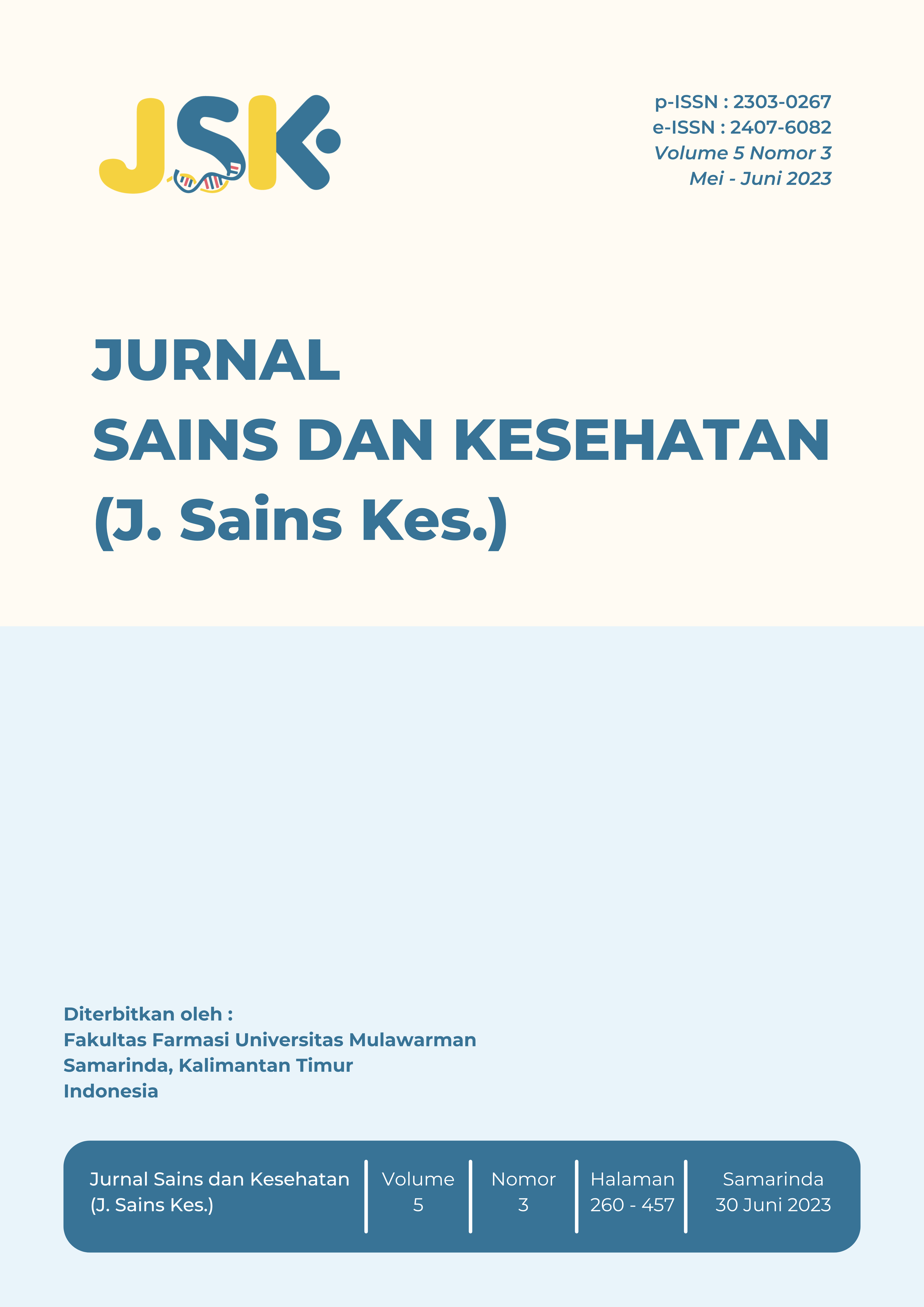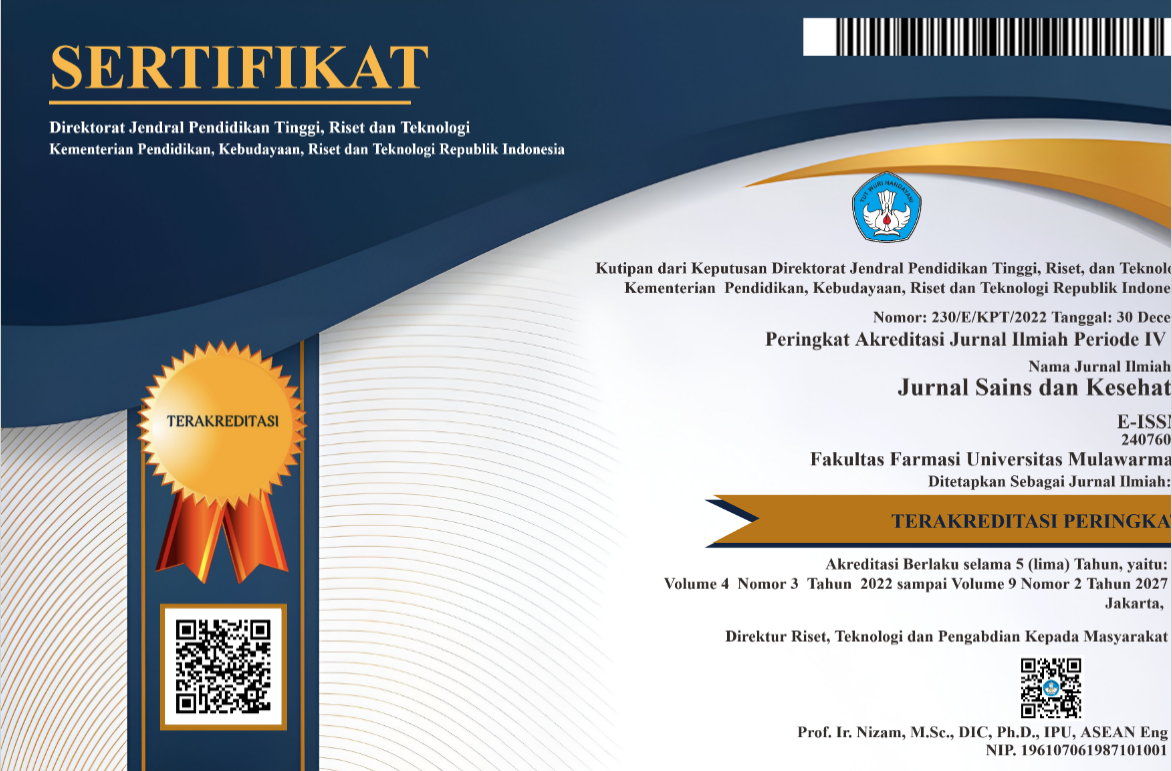Identifikasi Senyawa Aktif Pala (Myristica fragrans) sebagai Terapi Komplementer Antihipertensi melalui Penghambatan Reseptor ACE: Sebuah Studi Penambatan Molekuler
Identification of Acrive Compounds from Nutmeg (Myristica fragrans) as Complementary Antihypertensive Therapies Through ACE receptor Inhibition: A Molecular Docking Study
Keywords:
Antihipertensi, Myristica fragrans, Catechin, Beta-caryophyllene, Alpha-bergamoteneAbstract
References
Setiati S, Alwi I, Sudoyo AW, K MS, Setiyohadi B, Syam AF, 2014. Buku Ajar Ilmu Penyakit Dalam. 6th ed. Jakarta: InternaPublishing; 2014. 2259–83 p.
Singh S, Shankar R, Singh GP. Prevalence and Associated Risk Factors of Hypertension: A Cross- Sectional Study in Urban Varanasi. Int J Hypertens. 2017;2017.
Mills KT, Stefanescu A, He J. The global epidemiology of hypertension. Physiol Behav. 2016;176(1):139–48.
Kementerian Kesehatan Republik Indonesia. Laporan Nasional Riset Kesehatan Dasar. Kementerian Kesehatan RI. Jakarta; 2018.
Chowdhury MZI, Rahman M, Akter T, Akhter T, Ahmed A, Shovon MA, et al. Hypertension prevalence and its trend in Bangladesh: evidence from a systematic review and meta-analysis. Clin Hypertens. 2020;26(1).
Zhao Y, Xu C. Structure and function of angiotensin converting enzyme and its inhibitors. Shengwu Gongcheng Xuebao/Chinese J Biotechnol. 2008;24(2):171–6.
Luthfi M, Aziz S, Kusumastuti E. Rasionalitas Penggunaan ACE Inhibitor pada Penderita Hipertensi di Bagian Penyakit Dalam RSUD Kayuagung dan RSMH Palembang. Biomed J Indones. 2018;4(2):67–75.
Dicpinigaitis P V. Angiotensin Converting Enzyme Inhibitor- Induced Cough ACCP Evidence- Based Clinical Practice Guidelines. Chest J. 2006;129(1):169S-73S.
Abachi S, Bazinet L, Beaulieu L. Antihypertensive and angiotensin-i- converting enzyme (ACE)-inhibitory peptides from fish as potential cardioprotective compounds. Mar Drugs. 2019;17(11).
Wahyuni S, A. HE, Suparman N, Mardiana N. Keragaman Produksi Plasma Nutfah Pala (Myristica fragrans) di KP Cicurug. Bul Plasma Nutfah. 2016;14(2):68.
Akinboro A, Mohamed K Bin, Asmawi MZ, Sulaiman SF, Sofiman OA. Antioxidants in aqueous extract of Myristica fragrans (Houtt.) suppress mitosis and cyclophosphamide-induced chromosomal aberrations in Allium cepa L. cells. J Zhejiang Univ Sci B. 2011;12(11):915–22.
Ansory HM, Sari EN, Nilawati A, Handayani S, Aznam N. Sunscreen and Antioxidant Potential of Myristicin in Nutmeg Essential Oils (Myristica fragrans). 2020;26(Table 6):138–42.
Muchtaridi M, Fauzi M, Ikram NKK, Gazzali AM, Wahab HA. Natural Flavonoids as Potential for Anti- SARS-CoV-2. MDPI. 2020;2(August 2020):20.
Lipinski CA, Lombardo F, Dominy BW, Feeney PJ. Experimental and computational approaches to estimate solubility and permeability in drug discovery and development settings. Adv Drug Deliv Rev. 2012;64(SUPPL.):4–17.
Bhat V, Chatterjee J. The Use of In Silico Tools for the Toxicity Prediction of Potential Inhibitors of SARS-CoV-2. Altern Lab Anim. 2021;49(1–2):22–32.
Forli S, Huey R, Pique ME, Sanner M, Goodsell DS, Arthur J. Computational protein-ligand Forli S, Huey R, Pique ME, Sanner M, Goodsell DS, Arthur J. Computational protein-ligand docking and virtual drug screening with the AutoDock suite. Nat Protoc. 2016;11(5):905–19
Banerjee P, Eckert AO, Schrey AK, Preissner R. ProTox-II: A webserver for the prediction of toxicity of chemicals. Nucleic Acids Res. 2018;46(W1):W257–63.
Banerjee P, Dehnbostel FO, Preissner R. Prediction is a balancing act: Importance of sampling methods to balance sensitivity and specificity of predictive models based on imbalanced chemical data sets. Front Chem. 2018;6(AUG):1–11.
Drwal MN, Banerjee P, Dunkel M, Wettig MR, Preissner R. ProTox: A web server for the in silico prediction of rodent oral toxicity. Nucleic Acids Res. 2014;42(W1):53–8.
Arwansyah, Ambarsari L, Sumaryada TI. Simulasi Docking Senyawa Kurkumin Dan Analognya Sebagai Inhibitor Enzim 12-Lipoksigenase. Curr Biochem. 2014;1(in silico):36– 9.
Zafar A, Ahmad S, Rizvi A, Ahmad M. Novel non-peptide inhibitors against SmCL1 of Schistosoma mansoni: In silico elucidation, implications and evaluation via knowledge based drug discovery. PLoS One. 2015;10(5):1–33.
Jin J, Chen B, Zhan X, Zhou Z, Liu H, Dong Y. Network pharmacology and molecular docking study on the mechanism of colorectal cancer treatment using Xiao-Chai-Hu-Tang. PLoS One [Internet]. 2021;16(6 June). Available from: http://dx.doi.org/10.1371/journal.pon e.0252508
Cozier GE, Schwager SL, Sharma RK, Chibale K, Sturrock ED, Acharya KR. Crystal structures of sampatrilat and sampatrilat-Asp in complex with human ACE – a molecular basis for domain selectivity. FEBS J. 2018;285(8):1477–90.
Ali Y, Seong SH, Jung HA, Choi JS. Angiotensin-I-Converting Enzyme Inhibitory Activity of Coumarins from Angelica decursiva.
Ali A, Baby B, Soman SS, Vijayan R. Molecular insight in the interaction of hemorphin and its targets. Sci Rep [Internet]. 2019;9(1):1–16. Available from: http://dx.doi.org/10.1038/s41598- 019-50619-w
Prieto-Martínez FD, Arciniega M, Medina-Franco JL. Molecular docking: current advances and challenges. TIP Rev Espec en Ciencias Químico-Biológicas. 2018;21:65–87.
Trott,O., Olson AJ. AutoDock Vina: improving the speed and accuracy of docking with a new scoring function, efficient optimization and multithreading. J Comput Chem. 2019;31(2):455–61.
Dimmock & Lawlor. BDDCS, the Rule of 5 and Drugability. Physiol Behav. 2017;176(12):139–48.
Pantsar T, Poso A. Binding affinity via docking: Fact and fiction. Molecules. 2018;23(8):1DUMMY.
Macchiagodena M, Pagliai M, Procacci P. Inhibition of the Main Protease 3CL-pro of the Coronavirus Disease 19 via Structure-Based Ligand Design and Molecular Modeling. 2020;1–28. Available from: http://arxiv.org/abs/2002.09937
G?owacki ED, Irimia-Vladu M, Bauer S, Sariciftci NS. Hydrogen- bonds in molecular solids-from biological systems to organic electronics. J Mater Chem B. 2013;1(31):3742–53.
Varma AK, Patil R, Das S, Stanley A, Yadav L, Sudhakar A. Optimized hydrophobic interactions and hydrogen bonding at the target-ligand interface leads the pathways of Drug- Designing. PLoS One. 2010;5(8).
Francomano F, Caruso A, Barbarossa A, Fazio A, Torre C La, Ceramella J, et al. ?-Caryophyllene A Sesquiterpene with Countless.pdf. Appl Sci. 2019;9:5420.
Adefegha SA, Olasehinde TA, Oboh G. Essential oil composition, antioxidant, antidiabetic and antihypertensive properties of two Afromomum species. J Oleo Sci. 2017;66(1):51–63.
Ismaeel RO, Usman LA. Chemical Composition and Antioxidant Potential of Leaf and Rhizome Essential Oils from Zingiber officinale Roscoe var. colmondeleyi F.M.Bailey Growing in Nigeria. Chem Africa. 2021;(0123456789).
Oboh G, Olasehinde TA, Ademosun AO. Inhibition of enzymes linked to type-2 diabetes and hypertension by essential oils from peels of orange and lemon. Int J Food Prop. 2017;20(1):S586–94.
Isemura M. Catechin in human health and disease. Molecules. 2019;24(3).
Hettihewa SK, Hemar Y, Vasantha Rupasinghe HP. Flavonoid-rich extract of actinidia macrosperma (a wild kiwifruit) inhibits angiotensin- converting enzyme in vitro. Foods. 2018;7(9):4–11.
Additional Files
Published
Issue
Section
Deprecated: json_decode(): Passing null to parameter #1 ($json) of type string is deprecated in /home/jskff/public_html/plugins/generic/citations/CitationsPlugin.php on line 68
How to Cite
Similar Articles
- Muh. Nasir, Eri Marwati, Uji Aktivitas Antimikroba Ekstrak Etanol Daging Buah dan Daun Pala (Myristica fragrans) , Jurnal Sains dan Kesehatan: Vol. 4 No. SE-1 (2022): Spesial Edition J. Sains Kes.
- Mega Rizky Novitasari, Lizma Febrina, Risna Agustina, Agung Rahmadani, Rolan Rusli, Analisis GC-MS Senyawa Aktif Antioksidan Fraksi Etil Asetat Daun Libo (Ficus variegata Blume.) , Jurnal Sains dan Kesehatan: Vol. 1 No. 5 (2016): J. Sains Kes.
- Naksa Garnida Arfie, Bambang Subakti Zulkarnaen, Sudarmanto, Efektivitas Deferasirox pada Pasien Thalasemia Mayor: Artikel Review , Jurnal Sains dan Kesehatan: Vol. 4 No. 3 (2022): J. Sains Kes.
- Hasnaeni, A. Emelda, Sitotoksisitas Ekstrak Kayu Beta-Beta (Lunasia amara) pada Sel Kanker Payudara T47D , Jurnal Sains dan Kesehatan: Vol. 2 No. 3 (2020): J. Sains Kes.
- Mirfaidah Nadjamuddin, Marianti A Manggau, Cahyono Kaelan, Efek penggunaan Antihipertensi Kombinasi Amlodipin dan Valsartan Pasien Stroke Iskemik di RSUP Dr. Wahidin Sudirohusodo Makassar , Jurnal Sains dan Kesehatan: Vol. 3 No. 3 (2021): J. Sains Kes.
- Yasmiwar Susilowati, Tira Soleha Rahmatullah, Ahmad Muhtadi, Ferry Ferdiansyah Sofyan, Ami Tjitraresmi, Aktivitas Antihipertensi Ekstrak Kering Terstandarisasi Kelopak Bunga Rosela (Hibiscus sabdariffa L.) Hasil Produksi Skala Pilot , Jurnal Sains dan Kesehatan: Vol. 1 No. 10 (2018): J. Sains Kes.
- Hilmiati Wahid, Identifikasi Extended Spectrum Beta Laktamase (ESBL) Antibiotika Golongan Sefalosporin pada Bakteri Acinetobacter baumannii , Jurnal Sains dan Kesehatan: Vol. 2 No. 4 (2020): J. Sains Kes.
- Adam M. Ramadhan, Arsyik Ibrahim, Ayi Indah Utami, Evaluasi Penggunaan Obat Antihipertensi pada Pasien Hipertensi Rawat Jalan di Puskesmas Sempaja Samarinda , Jurnal Sains dan Kesehatan: Vol. 1 No. 2 (2015): J. Sains Kes.
- Raymond Elbert Budianto, Ni Made Linawati, I Gusti Kamasan Nyoman Arijana, Ida Ayu Ika Wahyuniari, I Gusti Nyoman Sri Wiryawan, Potensi Senyawa Fitokimia pada Tumbuhan dalam Menurunkan Kadar Glukosa Darah pada Diabetes Melitus , Jurnal Sains dan Kesehatan: Vol. 4 No. 5 (2022): J. Sains Kes.
- Muhammad Yusuf, Mawaddatur Rahmah, Sifat Mekanik dan Morfologi Poliblend Polipropilena dengan Poli(ε-Kaprolakton) yang Disintesis Menggunakan Katalis Zr β-diketonate sebagai Kandidat Material untuk Pembuatan Benang Jahitan Operasi , Jurnal Sains dan Kesehatan: Vol. 5 No. 3 (2023): J. Sains Kes.
You may also start an advanced similarity search for this article.




